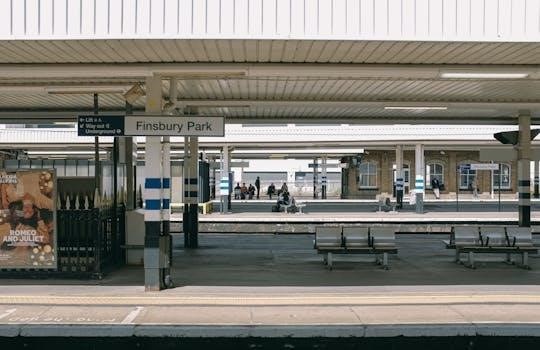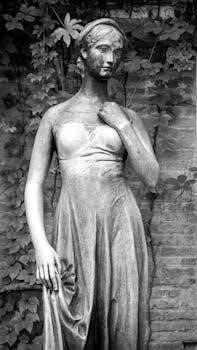Romeo and Juliet Prologue⁚ A Comprehensive Guide
Welcome to a comprehensive exploration of the prologue to William Shakespeare’s timeless tragedy, Romeo and Juliet․ This guide delves into the significance of this introductory section, setting the stage for the play’s unfolding events and previewing its central themes․
The prologue of Romeo and Juliet serves as a crucial entry point into Shakespeare’s tragic world․ Delivered by a chorus, it acts as a poetic summary, offering vital insights into the play’s core elements․ Think of it as a movie trailer, condensing the entire narrative into a concise and impactful preview․
By laying out key information regarding the plot, characters, and overarching themes, the prologue prepares the audience for the emotional journey ahead․ The audience gains an understanding that the play will unfold in Verona, Italy, involving two noble families locked in a bitter feud․
This feud, stemming from an ancient grudge, fuels the play’s central conflict․ Woven into this backdrop of civil strife is the ill-fated love story of Romeo and Juliet, star-crossed lovers whose destinies are intertwined with the families’ conflict․ Their tragic end, foreshadowed in the prologue, will ultimately bring peace to the warring households․ The prologue also sets the tone, hinting at the violence and sorrow that will permeate the play․
The Prologue as a Sonnet
The prologue of Romeo and Juliet is presented in the form of a Shakespearean sonnet, a poetic structure consisting of fourteen lines with a specific rhyme scheme․ This choice of form is significant, as the sonnet itself embodies themes present throughout the play such as love, beauty, and brevity․
Shakespeare’s sonnet structure includes three quatrains (four-line stanzas) and a concluding couplet (two-line stanza), typically following the rhyme scheme ABAB CDCD EFEF GG․ Within this structure, the quatrains introduce the central conflict and key elements of the story, while the couplet offers a resolution or final thought․
The sonnet form’s inherent elegance and structure contribute to the prologue’s impact․ The carefully chosen words and rhythmic flow capture the audience’s attention, setting a tone of heightened emotion and dramatic anticipation․ The use of iambic pentameter, with its alternating pattern of unstressed and stressed syllables, further enhances the sonnet’s musicality and memorability․ This poetic form provides a framework to understand the play’s tragic themes․
Setting the Scene⁚ Verona
The prologue explicitly establishes Verona, a vibrant city in Northern Italy, as the play’s setting․ The choice of Verona is not arbitrary; it provides a backdrop steeped in rich history and cultural significance․ In Shakespeare’s time, Italy was viewed as a center of both immense beauty and dangerous political intrigue, reflecting the contrasting themes of love and violence within the play․
Verona, described as “fair,” initially evokes a sense of beauty and promise․ However, this initial impression is quickly juxtaposed with the reality of the city’s internal conflict․ The prologue reveals that this beautiful setting is marred by an “ancient grudge” that has erupted into “new mutiny,” indicating a deep-seated societal unrest․
The physical location becomes more than just a backdrop; it is an active participant in the unfolding tragedy․ The city’s atmosphere of simmering tension and the ever-present threat of violence directly influence the characters’ actions and ultimately contribute to their tragic fate․ Verona, therefore, functions as a microcosm of the play’s larger themes, where beauty and love are constantly threatened by hate and destruction․
The Feuding Families
The prologue introduces two prominent households, both described as “alike in dignity,” residing within Verona․ This shared status emphasizes the senselessness of their bitter conflict․ The families, later revealed to be the Montagues and Capulets, are locked in an “ancient grudge,” suggesting a long history of animosity and violence whose origins are likely lost to time, fueling the cycle of hatred․
The phrase “alike in dignity” is significant․ It implies that both families possess social standing and influence within Verona․ This parity makes their feud all the more destructive, as it disrupts the city’s social fabric and involves the wider community in their conflict․ The feud is not merely a private matter; it spills into the streets, causing “civil blood” to make “civil hands unclean․”
The prologue highlights the irrationality of the families’ hatred․ Their inability to reconcile despite their shared status sets the stage for the tragic consequences that will befall their children․ The deep-seated nature of the feud will inevitably lead to the destruction of their offspring and serve as a catalyst for the events that unfold․
Star-Crossed Lovers⁚ Fate and Destiny

The prologue introduces Romeo and Juliet as “a pair of star-cross’d lovers,” immediately establishing the theme of fate and destiny․ This phrase suggests that their love is ill-fated from the outset, as they are born into families locked in a deadly feud; Their destinies are intertwined with the conflict, making their love a dangerous proposition․
The term “star-cross’d” implies that the stars, which were believed to influence human affairs, are in opposition to their union․ Their love is not simply a matter of chance; it is predetermined by a cosmic order that dooms them from the start․ The prologue hints that fate is a powerful force, shaping the characters’ actions and influencing their tragic outcome․
The idea of destiny is further reinforced by the prologue’s declaration that the lovers’ “misadventured piteous overthrows / Do with their death bury their parents’ strife․” This suggests that their deaths are not merely accidental; they are necessary to resolve the conflict between the families․ Their fate is intertwined with the resolution of the feud, making them pawns in a larger, predetermined plan․
Synopsis of the Play
The prologue functions as a concise synopsis of the entire play, condensing the complex narrative into a mere fourteen lines․ It reveals that the story revolves around two noble families, the Montagues and Capulets, locked in an ancient feud․ The setting is Verona, a city marred by civil strife and violence, where “civil blood makes civil hands unclean․”
The central conflict arises when Romeo Montague and Juliet Capulet, children of these warring families, fall deeply in love․ The prologue tells that their love is “star-cross’d,” meaning it is doomed from the beginning․ Their families’ animosity makes their union forbidden and fraught with peril․
Despite the obstacles, Romeo and Juliet pursue their love, leading to a series of tragic events․ The prologue foreshadows their eventual demise, stating that their “misadventured piteous overthrows” will ultimately bring an end to their families’ feud․ It unveils that the lovers’ deaths are not simply a tragedy but also a catalyst for reconciliation․ Through their sacrifice, the long-standing conflict is resolved, bringing peace to Verona․ The synopsis thus provides a framework for understanding the play’s themes of love, hate, fate, and reconciliation․
Themes Introduced in the Prologue
The prologue to Romeo and Juliet serves as a thematic microcosm of the entire play, introducing several key ideas that will be explored in greater depth throughout the subsequent acts․ One of the most prominent themes is the destructive nature of feud and hatred․ The prologue immediately establishes the animosity between the Montagues and Capulets, highlighting the senseless violence that plagues Verona․ This theme underscores the irrationality and devastating consequences of long-held grudges․
Another crucial theme introduced is that of fate and destiny․ The prologue refers to Romeo and Juliet as “star-cross’d lovers,” implying that their tragic end is predetermined․ This concept suggests that external forces, beyond their control, influence their lives and ultimately lead to their demise․ The idea of fate raises questions about free will and the extent to which individuals can shape their own destinies․
Furthermore, the prologue introduces the intertwined themes of love and death․ Romeo and Juliet’s love is passionate and intense, yet it is also inextricably linked to death․ Their love blossoms amidst violence and ultimately culminates in their tragic suicides․ This juxtaposition highlights the paradoxical nature of love, suggesting that it can be both a source of great joy and profound sorrow․ The prologue sets the stage for exploring the complexities of these themes throughout the play․
Civil Strife and Violence
The prologue of Romeo and Juliet wastes no time in establishing the pervasive atmosphere of civil strife and violence that grips the city of Verona․ The phrase “ancient grudge break to new mutiny” immediately signals a long-standing feud between the Montague and Capulet families, a conflict that repeatedly erupts into open hostility․ This ongoing animosity taints the very fabric of Veronese society, creating an environment of tension and unrest․
The prologue further emphasizes the severity of the conflict with the line “Where civil blood makes civil hands unclean․” This vivid imagery paints a disturbing picture of citizens engaging in acts of violence against one another, staining their hands with the blood of their fellow Veronese․ The use of the word “civil” underscores the tragic irony of the situation⁚ those who should be united by their shared citizenship are instead locked in a bitter and bloody struggle;
The violence depicted in the prologue is not merely random acts of aggression; it is deeply rooted in the societal structure of Verona․ The feud between the Montagues and Capulets represents a breakdown of order and authority, where personal vendettas take precedence over civic duty․ This breakdown creates a breeding ground for further violence, perpetuating a cycle of hatred and revenge that ultimately consumes the lives of Romeo and Juliet․
Love and Death Intertwined
From the outset, the prologue of Romeo and Juliet foreshadows the tragic entanglement of love and death that defines the play․ The phrase “star-cross’d lovers take their life” explicitly reveals the lovers’ ultimate fate, creating a sense of impending doom that hangs over their romance․ This predetermination suggests that their love is not destined for happiness but rather for a tragic end, a union consummated only in death․
The prologue’s emphasis on the lovers’ “misadventured piteous overthrows” further underscores the theme of intertwined love and death․ The word “misadventured” implies that their downfall is not solely the result of their actions but also a consequence of external forces, such as fate and the feuding families․ The adjective “piteous” evokes a sense of sorrow and compassion for the lovers, highlighting the tragic nature of their demise․
The intertwined nature of love and death in the prologue is not merely a plot device; it also reflects a deeper thematic concern․ Shakespeare explores the idea that intense love can be both a source of immense joy and a catalyst for profound sorrow․ In the case of Romeo and Juliet, their love transcends the boundaries of their families’ hatred, but it also ultimately leads to their destruction․ Their love becomes inextricably linked to death, a tragic testament to the power and fragility of human emotion;

The Chorus’s Role

The chorus in Romeo and Juliet‘s prologue serves as a narrator and commentator, guiding the audience’s understanding of the play’s events․ Presenting a synopsis of the plot, the chorus reveals key information about the setting, characters, and the tragic conclusion․ In doing so, the chorus prepares the audience for the emotional journey ahead, setting expectations and shaping their perception of the unfolding drama․
By delivering the prologue as a sonnet, the chorus elevates the story to a level of poetic significance․ The formal structure and elevated language of the sonnet lend a sense of gravity and importance to the events that are about to transpire․ This artistic choice also highlights the universality of the play’s themes, suggesting that the story of Romeo and Juliet is not merely a particular instance of tragedy but a reflection of fundamental human experiences․
Furthermore, the chorus acts as a moral compass, prompting the audience to reflect on the consequences of hatred and violence․ By explicitly stating that the lovers’ deaths will ultimately end the feud between their families, the chorus suggests that reconciliation and forgiveness are possible, even in the face of deep-seated animosity․ Thus, the chorus’s role extends beyond mere narration, inviting the audience to engage with the play’s ethical dimensions․
Language and Imagery Analysis
Shakespeare’s prologue to Romeo and Juliet is rich in language and imagery, immediately captivating the audience and foreshadowing the play’s tragic events․ The opening lines, “Two households, both alike in dignity,” establish the setting and introduce the central conflict․ The phrase “alike in dignity” suggests a shared social status, highlighting the senselessness of the feud that divides them․
The prologue employs powerful imagery to depict the destructive nature of the conflict․ “Ancient grudge break to new mutiny” illustrates how an old feud reignites, leading to further violence and bloodshed․ The phrase “civil blood makes civil hands unclean” vividly portrays the consequences of this violence, emphasizing the moral corruption and stain it leaves on society․
Shakespeare uses the term “star-cross’d lovers” to describe Romeo and Juliet, emphasizing the role of fate in their tragic destiny․ This image suggests that their love is doomed from the start, as they are pawns of forces beyond their control․ The prologue also employs contrasting imagery of love and death․ The phrase “piteous overthrows” foreshadows the lovers’ tragic demise, while the resolution of the feud is described as “death-mark’d love,” illustrating how love and death become intertwined․
Modern English Translation and Understanding
Shakespeare’s language, while beautiful, can present challenges for modern readers․ A modern English translation of the prologue to Romeo and Juliet is essential for a full understanding of its meaning and significance․ The opening lines, “Two households, both alike in dignity,” can be translated as “Two families, both of equal social standing․” This clarifies the equal status of the Montagues and Capulets, emphasizing the irrationality of their feud․
The line “From ancient grudge break to new mutiny” means “An old feud erupts into new violence․” This translation highlights the ongoing nature of the conflict and its escalation into open warfare․ “Where civil blood makes civil hands unclean” can be understood as “Where citizens’ blood stains citizens’ hands,” emphasizing the tragic consequences of the feud for the entire community․

Understanding the term “star-cross’d lovers” as “lovers destined for misfortune” is crucial to grasping the play’s central theme of fate․ The prologue’s synopsis, describing how the lovers’ deaths will end their parents’ strife, provides a framework for interpreting the play’s events․ By understanding the modern translation, audiences can appreciate the prologue’s function․
The prologue to Romeo and Juliet holds immense significance, functioning as a microcosm of the entire play․ In just fourteen lines, Shakespeare encapsulates the central themes, plot trajectory, and tragic destiny of the star-crossed lovers․ It serves as an essential guide for the audience, providing a framework for understanding the unfolding drama․ The prologue’s declaration of the lovers’ fate heightens the dramatic tension, as viewers watch the inevitable tragedy unfold․
The prologue also establishes the play’s setting in Verona, a city consumed by civil strife․ This emphasizes the societal context in which Romeo and Juliet’s love blossoms and ultimately perishes․ The mention of the “ancient grudge” hints at the deep-seated animosity between the Montagues and Capulets, fueling the cycle of violence that claims the lives of the young lovers․
Moreover, the prologue introduces the concept of fate, a recurring motif throughout the play; The “star-cross’d lovers” are destined for tragedy, their love thwarted by external forces beyond their control․ The prologue’s concise summary allows audiences to appreciate the play’s artistic structure․